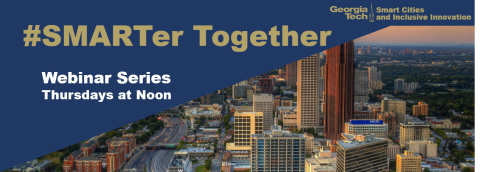event
#SMARTer Together Webinar - Autonomous Aerotropolis: A Digital Twin Model for Enhancing Smart and Connected Communities
Primary tabs
Register here!
Speakers include:
Dimitri Mavris, Regents Professor, Boeing Professor of Advanced Aerospace Systems Analysis, & Langley Distinguished Professor in Advanced Aerospace Systems Architecture Director, Aerospace Systems Design Laboratory (ASDL), School of Aerospace Engineering, Georgia Tech
Perry Yang, Associate Professor of City & Regional Planning and Architecture; Director, Eco Urban Laboratory, School of City & Regional Planning, College of Design, Georgia Tech
Olivia Pinon Fischer, Senior Research Engineer, Chief, Digital Engineering Division, Aerospace Systems Design Laboratory (ASDL), School of Aerospace Engineering, Georgia Tech
Michael Balchanos, Research Engineer II, Digital Engineering, Defense & Space Divisions, Aerospace Systems Design Laboratory (ASDL), School of Aerospace Engineering, Georgia Tech
Description:
Lack of connectivity between jobs and affordable housing has a significant impact on regional economic development. The Brookings Institution ranked Atlanta 91st out of the largest 100 metro areas in terms of share of accessible jobs via public transit, and the Atlanta Regional Commission (ARC) found that there was a spatial mismatch of jobs and housing in the metro region and further has included Hartsfield as one of the regional centers (10,000 jobs or more, in approximately 4 square miles). With focus on Atlanta’s Aerotropolis (“airport city”, namely the broader airport area along with the surrounding municipalities), the objective of this research is to provide city planners with recommendations for bridging the spatial mismatch between low-income employees at the Hartsfield-Jackson Airport and the broader Aerotropolis Atlanta Community Improvement Districts (AACIDs) through improved public transportation. The level of complexity, necessary understanding, and scoping for this problem has become the opportunity to define a collaboration “nexus” between Georgia Tech’s College of Design and the School of Aerospace Engineering, effectively bringing together ideas and methods from urban design and systems engineering, respectively. Driven by demographic and socioeconomic impact analysis of spatial mismatch, this joint effort has been relying on urban form design and mobility modeling techniques to explore solution alternatives through scenario-based use cases. Enabled by integrated Digital Twin technologies, scenarios that model population growth, impact of disruption (e.g., COVID-19 pandemic), and incorporation of transportation technology have been explored by multidisciplinary student teams. In this webinar, we provide an overview of this unique collaboration and its outcomes, as the result of fostering partnerships with community stakeholders (such as the AACIDs, Hartsfield-Jackson International Airport, MARTA, and members of the surrounding municipalities). Besides community-level efforts, on the academic side this initiative brought the introduction of the Smart Cities Workshop Class SCW (CP8873/AE8803-SCW), launched in Fall 2020, as a cross-discipline elective course, offered to graduate students on both academic majors.
Status
- Workflow status: Published
- Created by: kk151
- Created: 02/08/2021
- Modified By: kk151
- Modified: 02/11/2021
Categories
Keywords
Target Audience

